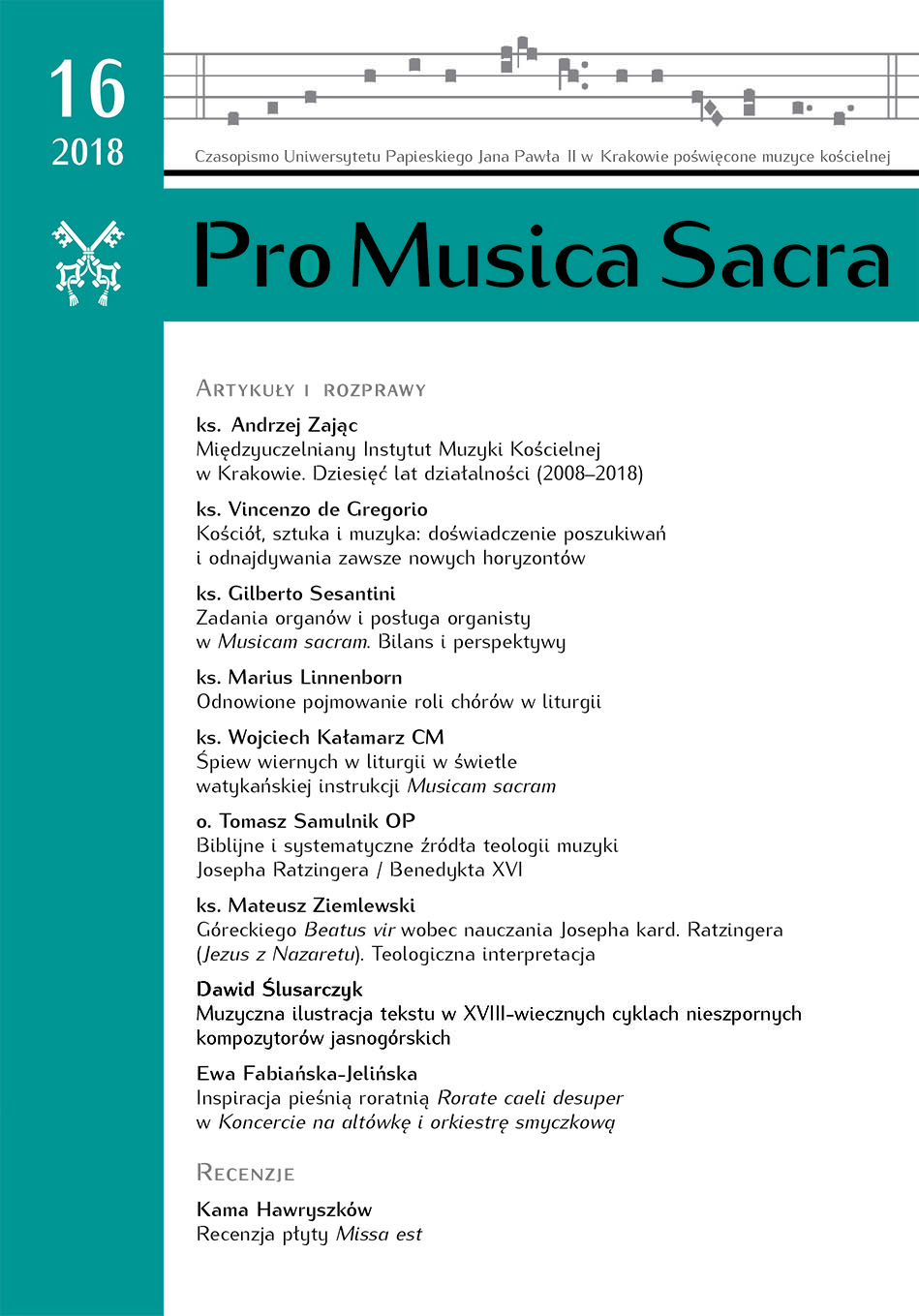Zadania organów i posługa organisty w Musicam sacram. Bilans i perspektywy
DOI:
https://doi.org/10.15633/pms.2577Keywords:
the instruction Musicam sacram, liturgy, music, pipe organ, organistAbstract
The position of a pipe organ in the liturgy of the Roman Catholic Church has been precisely clarified nowadays. Its major role is to support singing of the faithful, accompany choral bands and to perform solo music conformed with the character of a given feast or celebration. The instruction Musicam sacram of 1957 most clearly specifies when and on what occasions the organ ought to be used during liturgy and when its involvement is undesirable. These regulations appertain as well to organist’s service, defining its crucial role in building the community of the faithful.
The instruction Musicam sacram, issued 50 years ago, is not only a document of historical value. It has also become a launch pad for many subsequent documents regarding the church music. What is more, many specifications included in Musicam sacram are still relevant today. Recounting and analyzing some of its directions referring to the organ and organ playing allowed the author of this study to conclude that: “Nowadays, the liturgy still cannot cope without the organ and the organ cannot cope without liturgy. The dictum of Musicam sacram is clear, so is its mens (the so called «spirit»). As always, it is the hearts of people who are supposed to implement these regulations and who need repentance”.
References
Barba M., La riforma conciliare dell’Ordo Missae, Roma 2008.
Benedetto XVI, La musica, un’arte familiare al Logos, Città del Vaticano 2009.
Bugnini A., La riforma liturgica (1948–1975), Roma 1983.
Donella V., La musica nella liturgia dal Concilio Vaticano II ad oggi, Verona 2012.
Graduale simplex, editio tipica altera, Città del Vaticano 1975.
Graduale simplex in usum minorum ecclesiarum, Città del Vaticano 1967.
Hugo V., Les chants du crépuscule, 33: Dans l’église de ***, I., 1835.
Kongregacja Kultu Bożego, instrukcja o muzyce w świętej liturgii Musicam sacram.
L’arte di Dio. Sacri pensieri, profane idee, ed. C. Siccardi, Siena 2017.
Rainoldi F., Sentieri della musica sacra. Dall’Ottocento al Concilio Vaticano II. Documentazione su ideologie e prassi, Roma 2000.
Ratzinger J., Lo spirito della liturgia. Un’introduzione, w: Opera omnia, t. 11, Teologia della liturgia, Città del Vaticano 2010.
Ruff A., Sacred music and liturgical reform. Treasures and transformations, Chicago 2007.
Sessantini G., L’improvvisazione organistica nella liturgia, „Arte Organaria e Organistica” 4 (1997) 18, s. 37–39 i 5 (1998) 24, s. 30–33.
Sessantini G., L’organo nella liturgia tra Cinque e Seicento, w: AA.VV., L’Organo Antegnati 1558–1996, Almenno S. Salvatore 1996. Zarlino G., Sopplimenti musicali, Venezia, Francesco de’ Franceschi, 1588.
Stefani G., Friburgo: prima settimana mondiale della nuova musica sacra, „Rivista Liturgica”4 (1965), s. 492–498.
Downloads
Published
Issue
Section
License
Copyright (c) 2018 Gilberto Sesantini

This work is licensed under a Creative Commons Attribution 4.0 International License.
Authors who publish with this journal agree to the following terms:
- Authors retain the copyright and full publishing rights without restrictions, and grant the journal right of first publication with the work simultaneously licensed under a Creative Commons Attribution 4.0 International License that allows others to share the work with an acknowledgement of the work's authorship and initial publication in this journal.
- Authors are able to enter into separate, additional contractual arrangements for the non-exclusive distribution of the journal's published version of the work (e.g., post it to an institutional repository or publish it in a book), with an acknowledgement of its initial publication in this journal.
- Authors are permitted and encouraged to post their work online (e.g., in institutional repositories or on their website) prior to and during the submission process, as it can lead to productive exchanges, as well as earlier and greater citation of published work (See The Effect of Open Access).

